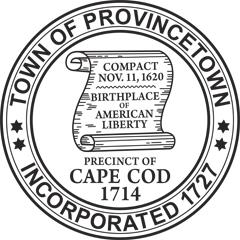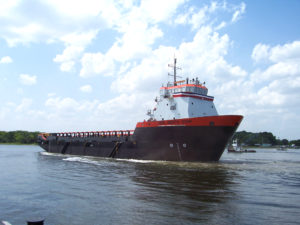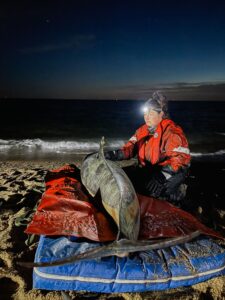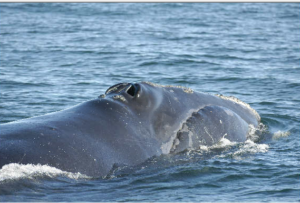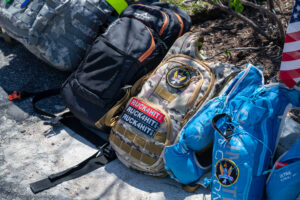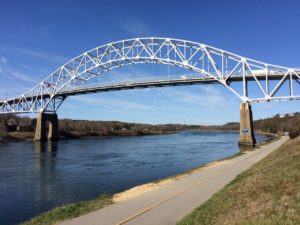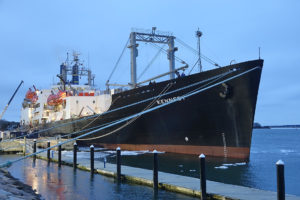
The T.S. Kennedy is the current training vessel used by Massachusetts Maritime Academy.
BUZZARDS BAY – Although it is still four years away, Massachusetts Maritime Academy administration and staff are excited and waiting to receive a new training ship.
Senator Edward Markey made a formal announcement at the school’s commencement that the current federal budget includes $300 million for a vessel to replace the 52-year-old T.S. Kennedy.
The federally owned vessel was originally built in 1967 and was converted into the training ship in 2003. It was renamed the T.S. Kennedy in 2009 following a $10 million rehabilitation.
The new vessel is expected to be completed in 2023.
Rear Adm. Francis McDonald, the president of MMA, said everyone at the academy is ecstatic about receiving a new vessel, including first year cadets, who won’t be here to sail on the ship.
“They realize how important it is for the long-term health of the academy,” McDonald said.
McDonald said staff and alumni are really excited.
“It’s something that everybody has been paying attention to and keeping an eye on for many many years,” he said.
“When we think about this size of investment from the federal government, $300 million, that’s a sizable investment and it backs up the fact that we play an important role, not only for the Commonwealth but for also for the nation.”
McDonald said a construction management firm has been named and a shipyard is expected to be selected by the end of the year.
Markey, who serves on the Senate’s Commerce, Science and Transportation Committee, which has control over maritime academies, worked to secure the funding with members of the House.
“This has been a year’s long effort,” McDonald said. “The old way of getting training ships was to chase an earmark and find an old freighter or tanker and try to spend $50 million to convert that hull into a training ship.”
McDonald said that process is not the most efficient way to train tomorrow’s maritime leaders.
MMA officials have been working closely with the Maritime Administration and other state maritime academies to show the importance of the schools, and for the assets to be used by the federal government in times of national emergency.
The current training ship was deployed to Texas and then St. Thomas and Puerto Rico to help with hurricane relief efforts following major storms Harvey and Maria.
The size and capacity of the new vessel will be similar to the Kennedy. It will be about 550 feet long and carry 600 cadets and 130 officers, faculty and crew.
The vessel will also feature purpose built training systems with state-of-the-art technology being used in the industry.
McDonald said the new technology will be a far cry from the tech that was state-of-art when the Red Sox had their “Impossible Dream” summer in 1967.
The vessel will also be more designed for its multi-mission use to support FEMA.
It will also include a roll-on/roll-off support area and a hospital area that will be able to be expanded.
McDonald said they will be able to use the vessel, like they do with the Kennedy, and park it in remote locations that suffered major damage from hurricanes or other storms.
“It will be able to immediately deploy 400-600 FEMA workers right there making their own electricity, their own water and being able to sustain an immediate response to an area that was just devastated,” he said.
The vessel is also used for the annual winter sea term for students, which features several ports of call in warmer areas of the Atlantic.
Cadets rotate through ships operations including deck and engine watches, classes and laboratory training at sea, and maintenance and emergency drills.
“It will have a roll-on roll-off support area and a hospital area that will be able to be expanded,” McDonald said. “We’ll be able to still take these assets, like we have done with Kennedy, and park them in a remote location that possibly just got wiped out by a hurricane, and immediately deploy 400-600 FEMA workers right there making their own electricity, making their own water and being able to sustain an immediate response to an area that was just devastated.”
McDonald said the current condition and age of the Kennedy is the largest threat to the academy as the vessel is already significantly past its predicted life.
The vessel is scheduled to go into dry dock every two or three years.
“And anyone of those dry dock periods could uncover something that becomes catastrophic as far as the overall sailability and seaworthiness of the vessel,” McDonald said.
The absence of a training ship would be a major impact to the school.
“The role our grads play, not only in our nation’s economy but also in supporting our nation’s defense, would be extremely diminished because we sit as the largest of the state maritime academies producing the most mariners for the nation,” McDonald said.






